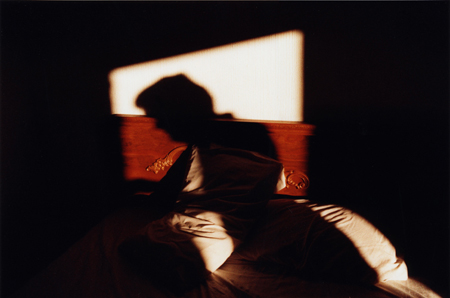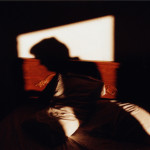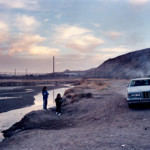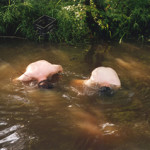By SHANE LAVALETTE
Shane Lavalette: How did you first discover photography and when did you realize it was the right medium for your ideas?
Michael Schmelling: My parents have had an interest in photography, both as a hobby and as collectors of sorts, since the early ‘70s. When I was a kid, they built a darkroom in the basement. Around the same time, my mother started collecting photos from the 19th century American West, mostly anonymous or uncredited work, some Edward Curtis books, photos of Indians and desert landscapes. Lots of dusty brown photos that she’d hang in the living room; I wasn’t sure if we were supposed to visit these places, or just tell stories about them. Anyway, just before high school, she convinced me to take a photo class. So I started taking pictures of friends, started working for the newspaper, etc.
I also remember at this time, in high school, finding Bruce Davidson’s Subway and Avedon’s In The American West in the high school library… Someone tore out the photo of the crazy lady pulling up her skirt from Subway. I don’t know how formative those were, but that’s when I started looking at photography as a creative medium, and saw the photo book as a vehicle for its stories.
But it wasn’t until I was in my first year of college that I felt like I could work a life out of photography, or try anyway. I was stuck at a small school in Iowa, majoring in liberal arts, uh, and taking a couple photo classes. That’s when I figured out the first steps, anyway. The realization that I could use photojournalism or documentary work as a means to experience things, and tell stories, was really exciting. (At the time I was pretty set on being a photojournalist).
So I moved to New York, went to NYU, got into street photography, and moved on from there.
SL: I’m familiar with the photographs from your book Shut Up Truth, published by in 2002 by J&L. When did this project begin? Who is the protagonist, James Holloway?
MS: I got a post-graduate fellowship from NYU, more or less an open-ended ticket to go somewhere and pick something to shoot. So I picked El Paso and moved down there for a while. For money, I took a job on a film that was being shot out in the desert, a Bruce Willis B-movie called Last Man Standing. James was working as the union projectionist on the set, projecting the dailies. He’d also just moved to town, so when the movie left, we started hanging out. I took a few pictures of him from this time (one of which ended up in the book) but the project really began in 2000 when I started making trips back to El Paso. I was kind of burnt out from the photojournalism work I’d been doing for the Associated Press in New York, and I was looking to get back to where I’d started, or try to get back there, pick up the thread, simplify things. Most of the photos were taken in El Paso, and a few are from a trip we took into Mexico.
SL: Tell me about El Paso.
MS: You come in from the desert, drive past miles and miles of retail stores, a Whataburger and a Carl’s Jr., you pass through the old parts of town, past the empty park at the intersection of Montana and Ange, (if you’re lucky you’ll stop off for some food at H+H Car Wash), past more malls, past the offices of J.J. Armes, past the airport, through the mountains, past the Rio Grande (it may not look like a river, but it’s there out your left window, the old Asarco plant is on your right), and then just outside of town you’ll hit the desert again, a pack of stray dogs will be trotting aimlessly up ahead (thank you John Divola), you’ll have a chance to take the bridge over to Mexico, but you’ll probably just cross the train tracks up ahead and end up in New Mexico.
Like its name implies, El Paso has always been thought of as a byway, a transit spot, literally “the pass.” And of course it’s a border town, flush with all the problems that face most border towns: drugs, gangs, immigration, and pollution. A million or so people have cozied up to that border and stayed, and plenty more are stuck there.
It’s not thriving, but it’s definitely alive. It doesn’t feel abandoned, like one of our long-defunct Mid-western cities, but it never feels completely modern either. Maybe it’s just like one of those old western towns, set constantly between flux and stagnancy, the old and new?
Obviously I like to romanticize things a bit, and there’s plenty of room for that out in the desert.
SL: What is the meaning of the title, Shut Up Truth?
MS: James has always been interested in, or fixated with, what I would categorize as, dogma. He’s fascinated with communism and the moral battles of the cold war. He’s made several trips to North Korea, Cuba, Russia and Viet Nam. James was also deeply involved with fundamentalist Christianity, and Christian activism, when he was younger. He still attends mass with The Church Of Christ regularly.
James also has a relatively slight case of Tourette’s syndrome; you might not notice it unless you spent some time with him. But what’s interesting about his Tourette’s, is that it’s largely manifested by the repetition of certain phrases from his youth. “Shut up truth” is one of those phrases, it comes from a sermon he heard years ago in Dallas. It’s a bit of an inside joke he has with himself, and now with me.
Given the ever-present (and surprisingly never ending) conversation about “truth” in photography, it makes for a pretty good photo book title. In that respect, it’s also a subtle way to enter in to that conversation and express my skepticism towards the more heavy-handed ideals of old world photojournalism, and book titles like Truth Needs No Ally.
James just left a voicemail for me the other day, telling me that my next book should be called “Shut Up Error.”
SL: With your photographs, you’ve managed to take what seems to be the ordinary moments of James’ every day life and find both the humor and beauty within them. What do the moments you’ve captured mean to you? Are they simply a record of your friendship with James?
MS: At the time, I may have used that exact phrase, “a record of our friendship,” but it sounds a little dramatic right now… (Not coming from you! From me).
But that was the more or less the intention, to create a record. I always referred to it as “a record of time spent”… (Still sounds a little dramatic? Well, it’ll have to do). As general as that sounds, I was hoping to convey how simple my intentions were. I was really only interested in depicting my friendship with James, and locating it in this place, El Paso. Depicting a place a time and person. I tried to strip everything down, and flatten things out visually. I also had this hope that it would somehow turn out looking anonymous, but I don’t think that aspect ever worked…
For me, on any project, the primary meaning comes from the experience itself. Discovering something through the process, that, hopefully, is then communicated to the viewer when all’s said and done.
There might be a few pretty pictures in there, but I don’t feel like I’m very good at taking beautiful pictures. But, I guess those photos are closer to “beautiful” than anything else I’ve got.
One of these days I’m gonna make something beautiful, I swear.
SL: In that respect, Shut Up Truth seems to be nothing short of a labor of love. When you began making the photographs, did you imagine them coming together as a book three years later?
MS: It was just a couple of years… I pictured it as a series, but I didn’t look at it as a book until I was asked to publish it.
SL: There’s a certain level of trust involved in the capturing of such intimate moments. Was it just a matter of time before James was open to the camera? What was his response to being photographed so much?
MS: Since James is a projectionist, he’s always had a fascination with cameras and film. He wasn’t a stranger to the process, but he hadn’t been photographed much in his life. Somehow that made him really open and relaxed. And I got really obsessed with that, his lack of self-consciousness, and the way he presented himself.
I was pretty up front about the idea for the project, told him what I had in mind, and thankfully he was really into it. He got a real kick out of it, and I felt like we were collaborating at times (or at least I hope we were).
SL: The other project of yours that I’m familiar with is The Plan. I noticed the images from this series in the Summer issue, Issue 35of Blindspot. Where were these photographs taken? Who are the Disaster Masters? What exactly is “The Plan”?
MS: Disaster Masters is a small hands-on company based in Queens that specializes in cleaning out homes and counseling hoarders, among other things.
These photos were all taken in the New York City area. Most are from apartments in the city itself. A few are from the suburbs, just outside the city.
“The Plan” is both the name of the Disaster Masters website (theplan.com), and their 800 number (1-800-THE-PLAN). It’s meant to infer that they have a plan to get a problem taken care of, a job done.
Like Shut Up Truth, The Plan has more than one connotation. In this instance, “The Plan” can also be the intentions we have to utilize the things we own or save. “The Plan” to clean stuff up, read a book, wash the dishes, start a project, clip coupons, send a letter, etc. Either way, The Plan implies a bit of optimism (and failed optimism).
And then there’s also those old rainy day plans.
SL: So, what happens if I dial 1-800-THE-PLAN?
MS: I suppose a receptionist will answer your call. They’re really nice people, ready to help, if you need it.
SL: The anthropological aspect of this task must be entirely fascinating. Are the Disaster Masters as amused by their job as they seem to be in some of the pictures?
MS: That’s what immediately fascinated me – the urban archeology, the anthropological aspect of the work. And I think that’s part of the appeal for them as well; it’s certainly not a boring job. But it’s rough work, messy work, and many of these homes are extremely hazardous. I don’t think they are necessarily amused by their jobs, that sense of humor could be better read as an attempt to bring levity into a rough situation. Ron, the head of Disaster Masters, has a really charismatic personality, he’s amazing at ingratiating himself with the clients, and he’s a great boss. Some of his humor helps move the process along. And I would assume that my own presence spurred some of that show-and-tell aspect as well.
SL: How were you able to make these images? Was access a problem?
MS: I made several other attempts to gain access to homes through other channels. I attended a workshop with another clutter-counselor, and I spoke with members of the medical community that specialized in “Obsessive Compulsive Hoarding Disorders.” But in the end, once I’d met the Disaster Masters crew, I became more interested in following the story through them.
From the beginning, I knew that I didn’t want to take portraits of hoarders, sitting in their homes with their stuff. I wasn’t sure how I would go about it, or what direction it would take, but I’m glad I found a way in to the project, both literally and creatively.
There were plenty of jobs that I couldn’t work on with them, due to space, or sensitive issues with the clients. So, access wasn’t always easy.
SL: The photographs themselves have a sort of de-saturated aesthetic reminiscent of expired color film. The brightly flashed close-ups (masses of clutter, stains, dirty tiles, finger prints, peeling paintjobs, etc.) make me think of how someone like Martin Parr chooses to render the world. What does such an aesthetic bring to the project? Are you influenced by the way Parr depicts the surface of objects? I suppose I’ll just ask in general, are there any photographers that have had a big influence on the way you work?
MS: I’ve always been really interested snapshots and found images, and I wanted to work that aesthetic into the project. I love how snapshots have a feeling of being both personal and universal. They also feel somewhat disposable, which I like as well. Hopefully those notions all bring something to the project, and make it feel more immediate. I also liked the idea of amassing more of a physical product from a story that was so clearly about the problem of holding on to… stuff, so I printed everything as 4×6 prints and watched the boxes pile up.
And quite practically, it was the best way to work in these situations.
That comparison may have some resonance, but probably the best way to bring Martin Parr into this discussion is to look at him as a consummate collector and semi-obsessive. He’s probably best known for the kind of work you mention, but for some reason I’ve never felt an affinity for it. When I think of his work, the work I really love, I think of his pictures from Brighton and his earlier work. I guess I’m always looking for something a bit more personal, and I don’t think I could ever approach a project the way he has withThink of England or Mexico. On the other hand, his work has an objective specificity and clarity that I would hope shows up in my own work as well.
All that said, the books Evidence by Mike Mandel and Larry Sultan and White Noise by Don DeLillo, along with a handful of found images, have probably influenced this project more than anything else.
SL: It’s interesting to think about the photographs of specific objects as perpetuating the very tendency that the Disaster Masters set out to stop. In other words, by photographing them you seem to have preserved the object and also birthed new ones – objects that are also for sale. Additionally, your photographs can be reproduced as many times as you choose to print them. Is this something you were thinking about? Did you ever consider limiting it to one print to represent each object?
MS: Exactly! With photography in general, it’s hard not to amass things constantly. But yeah the quantitative aspect of the project was always in mind. I like the idea of smaller editions… Or maybe it should just be an unlimited edition, keep things piling up.
SL: In the exhibition that you had in 2005 at Bucket Rider Gallery in Chicago, viewers were able to peruse some of the actual items that you collected from the sites that were photographed and also read some found poetry (in the form of lists of book titles that you came across). How do you think people reacted to this experience versus looking at the photographs?
MS: It worked really well in that space. I like to think that each project has sources or footnotes, or even a totally different way of looking at it, presenting it. I treated the room at Bucket Rider that way, as just another version of the same project. There were people who wanted to place it in a sculptural or installation art context, but I was really only thinking of it as pure information. Similarly, inthe book of The Plan (to be published by J&L, 2008), there is an appendix that is meant to give the viewer another way to read the project, a distilled version, more or less.
SL: Is this a problem that you yourself face – do you also struggle with throwing things away?
MS: I have some obsessive quirks of my own, which actually led me to the project, but I don’t have a problem with clutter. In fact the shock of working in some of these spaces always makes me go home and throw stuff out. I have the opposite problem now. Except, I’m a photographer, so I’m generating boxes worth of stuff every month. Believe me, I think about it!
SL: None of your photographs actually depict the subjects with obsessive-compulsive hoarding problems. Would you say that these images, even though they mostly describe interior environments (or objects and surfaces), amount to more or less portraits of the individuals who have amassed these piles?
MS: Yeah that’s accurate to some extent. That’s part of the thrill of being in anyone’s home, and learning about someone through their environment. But even if we’re able to learn a lot about these people, it’s purely a surface reading. And even if there were pictures of the people here, I wouldn’t claim that their portraits somehow depict them fully either. Drawing any definitive conclusions would be a bit like building a persona based on the records and books you posted on Facebook. But that’s always fun too.
SL: Would you say that these photographs speak about the larger issue of consumerism?
MS: Sure, it’s unavoidable, but I’m certainly not looking to preach, or foreground the issue. I’m a bit skeptical of work that functions solely as a metaphor for larger social or political issues.
I’m more interested in depicting something specific, and then letting the discussion go on from there. And these pictures are great for that, everyone can relate to the personal aspect of the spaces, the specificity of the objects, and then expand the conversation to broader issues.
SL: It’s rare that I find editorial photography that I’m really fond of (especially by a photographer whose “fine art” work I also connect with). Somehow, I think it’s very difficult to play both cards successfully – maybe this has something to do with our tendency to keep the two separate? I think you do a great job producing inspired work in both fields. Do you find yourself drawing a line between your editorial and your fine art work or do you approach your assignments similarly?
MS: There’s a line, but I find it tends to shift. It really differs from job to job. Honestly, I never feel like I’m that comfortable with the balance, or lack-of. I definitely feel better about my editorial work when I’ve gotten close to doing something exactly as I would have done it for myself. But that’s always a bit of a battle, so dependent on the subject, and way too elusive. There are a handful of great photo editors that give a lot of direction, tap in to what you do best, and find a way to fit you into an assignment. Those are always the most gratifying experiences.
The other problem being that I like to try lots of different things. I like the nature of the job, the “trade” aspect of being a photographer, trying different assignments, problem solving. It’s fun to apply what you know to a new idea or technique. I’m not that experimental by any means, but I like to think I’m open to the possibilities of what’s out there.
SL: We’ve only really talked about two, but you have a number of projects. How do you move from one to the next? What are you working on now?
MS: I can’t say exactly how I choose a project. I’d love to be more prolific, but I can’t get into something unless it feels a bit organic (a mutable notion, I know), or at least “an organic expression” as I heard Norman Mailer say this past summer. Like most people, I keep a list of things I’d like to work on. Many of which never get done. But I do my best to follow what interests me, and find a way to work on it.
Right now I’m in the middle of a project that is sort of half-commissioned, and half my own – a book project on Outkast. I’ve also been working on a project about memory and memorization. And another nascent project or two…
- Michael Schmelling, Untitled (Shadow), Mexico (from “Shut Up Truth”), 2001
- Michael Schmelling, Untitled (Rio Grande), El Paso, Texas (from “In El Paso”), 1996
- Michael Schmelling, Brass Castle, Macon, GA, 2006
Michael Schmelling
Shane Lavalette / Journal
All images are courtesy of the artist.







